Love a good savory pancake? This Korean Pancake (Pajeon 파전) recipe with scallion and shrimp is absolutely delicious! Enjoy it with my spicy soy dipping sauce.
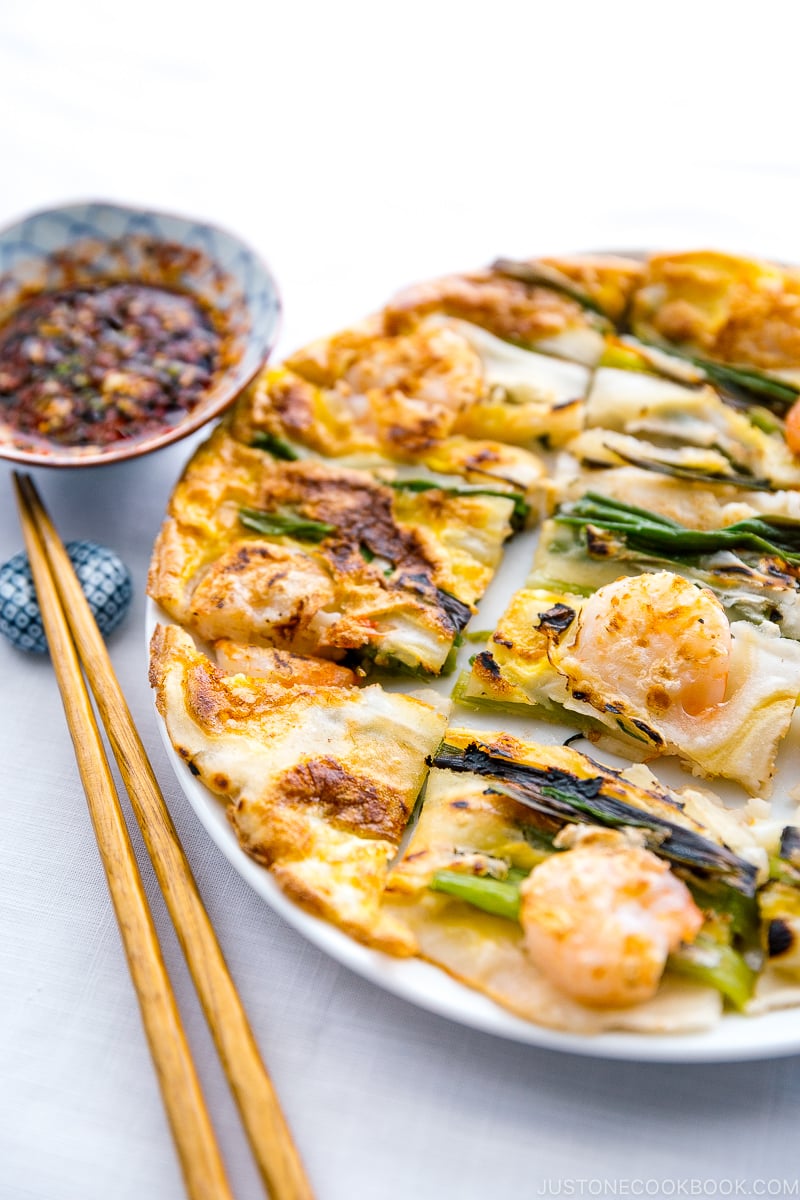
When we go out to Korean restaurants, my family always fights over the last piece of our favorite Korean Pancake or Pajeon.
At home, I sometimes make these pancakes for the kids after school before we head out to their after-school activities. They love hanging out in the kitchen with me and seeing how I make these pancakes. As soon as the pancakes are done, everyone dips them in the sauce and enjoys small bites of crispy pancakes.
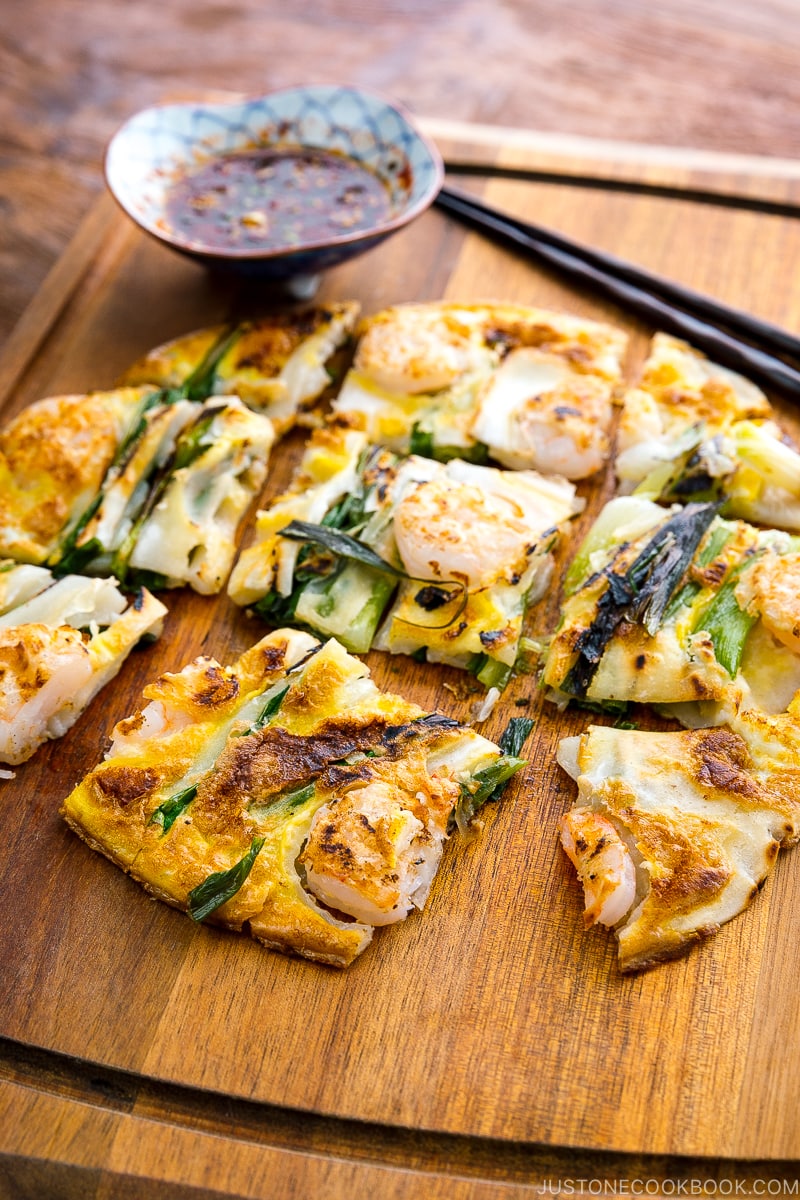
Ingredients for Korean Pancake
Scallions are important for this recipe, and you can easily make it into vegetarian by omitting prawns. If you love seafood, you can add squid (Haemul Pajeon – seafood pancake). Prefer meat instead? You can substitute with thinly-sliced pork belly slices. It’s so flavorful and delicious! Whatever flavor you decide to go with, I’m sure your pancakes will turn out great! These crispy pancakes are seriously quite addicting!
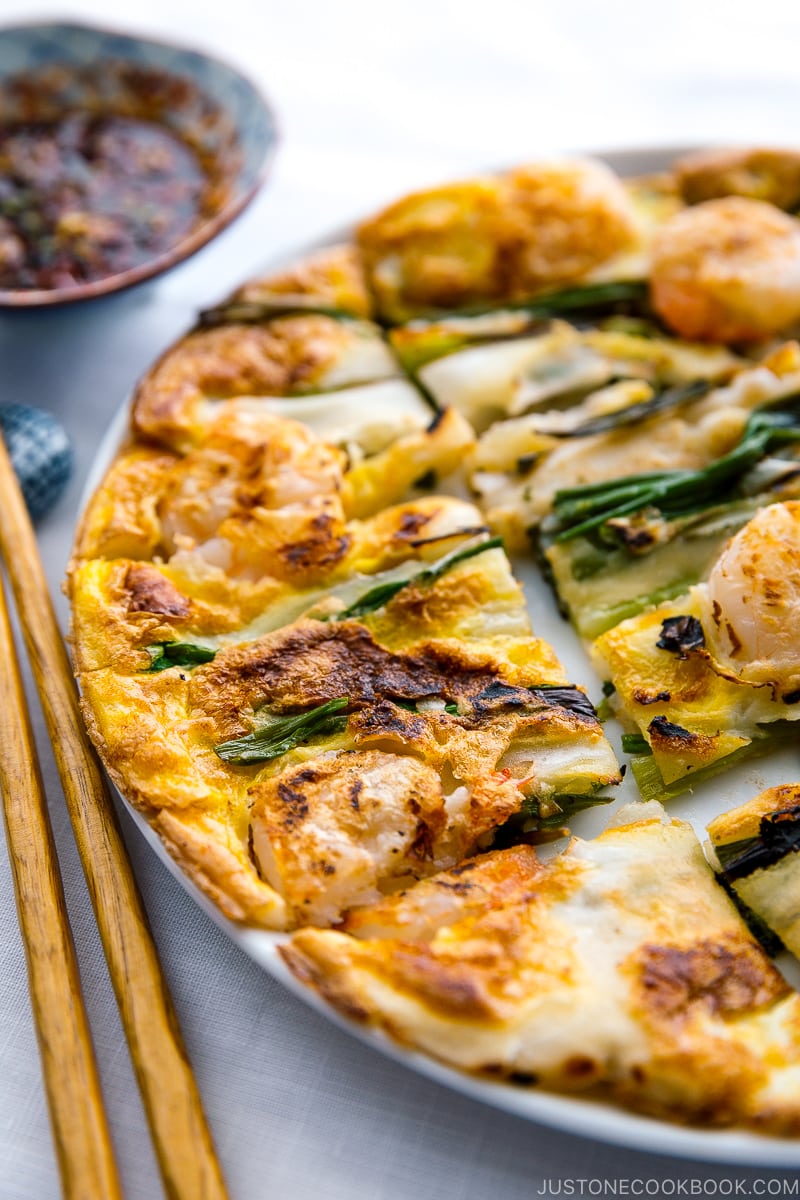
Unique Texture of Korean Pancake
For this recipe, I used cake flour (薄力粉) instead of all-purpose flour. Cake flour is wheat flour that has a lower viscosity and protein content. My Korean friend suggested using it instead of regular flour, and the result was like the restaurants’. By using cake flour, the texture is crispier and lighter than using all-purpose flour.
Cake flour is available in the bakery section of supermarkets. If you can’t find it or want to make it yourself at home, please see my note in the recipe (below). I explained how to make cake flour by mixing 2 ingredients: all-purpose flour and cornstarch (super easy!). Of course, you can use all-purpose flour as well but it’ll be less crispy.
My mom recently shared another recipe with me that uses all-purpose flour and rice flour, and she said it’s pretty amazing. I’ll be testing out her recipe next time.
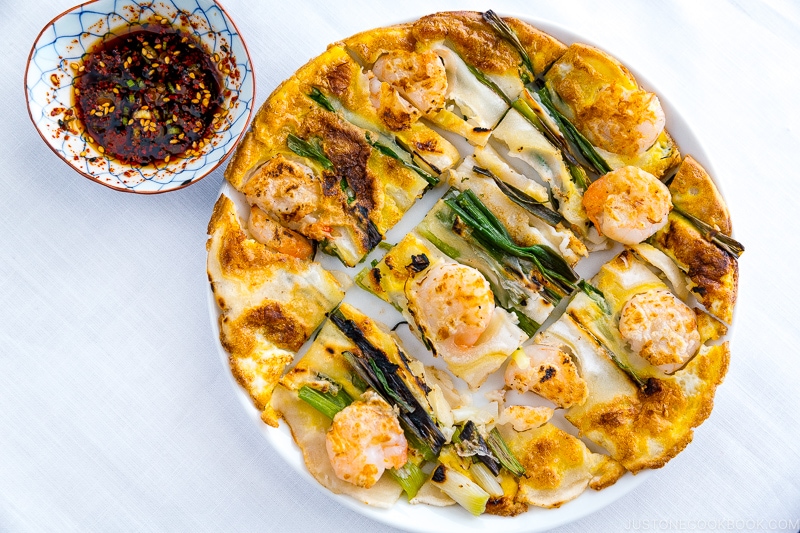
Wish to learn more about Japanese cooking? Sign up for our free newsletter to receive cooking tips & recipe updates! And stay in touch with me on Facebook, Pinterest, YouTube, and Instagram.
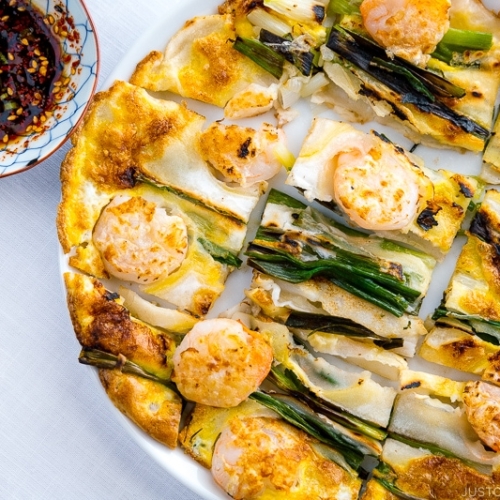
Korean Pancake (Pajeon)
Video
Ingredients
For the Spicy Dipping Sauce
- 1 Tbsp soy sauce
- ½ Tbsp rice vinegar (unseasoned)
- 1 tsp green onions/scallions (thinly sliced)
- ¼ tsp gochugaru (Korean pepper flakes)
- ¼ tsp toasted white and black sesame seeds
- ⅛ tsp sugar (optional, to counter the vinegar‘s acidity)
For the Pancake
- 1 bunch green onions/scallions (about 10 stalks; don’t reduce the amount; use enough to fill the pan so that the pancake holds together when flipped)
- ½ large egg (50 g each w/o shell) (beaten; use half an egg per pancake)
- 1½ Tbsp neutral oil
- 4 oz shrimp (cleaned and deveined)
For the Batter
- ½ cup cake flour (weigh your flour or use the “fluff and sprinkle“ method and level it off; you can make homemade cake flour)
- ½ tsp Diamond Crystal kosher salt
- ½ cup cold water or sparkling water (add slowly as you check the consistency of the batter; you may not need all of it)
Instructions
- Gather all the ingredients. I highly encourage you to weigh your ingredients using a kitchen scale for this recipe. Click on the “Metric“ button at the top of the recipe to convert the ingredient measurements to metric. If you‘re using a cup measurement, please follow the “fluff and sprinkle“ method: Fluff your flour with a spoon, sprinkle the flour into your measuring cup, and level it off. Otherwise, you may scoop more flour than you need.

- Combine all the ingredients for the spicy dipping sauce—1 Tbsp soy sauce, ½ Tbsp rice vinegar (unseasoned), 1 tsp green onions/scallions, ¼ tsp gochugaru (Korean pepper flakes), ¼ tsp toasted white and black sesame seeds, and ⅛ tsp sugar (optional). Set aside.

- Cut off the ends of 1 bunch green onions/scallions. Then, cut the scallions in half crosswise. If you’re worried about flipping a large pancake, cut the scallions shorter and make smaller round pancakes so you can easily flip them.

- Beat ½ large egg (50 g each w/o shell) in a small bowl. Set aside half an egg per pancake for cooking.

- To make the batter, combine ½ cup cake flour and ½ tsp Diamond Crystal kosher salt in a medium bowl. Slowly add ½ cup cold water or sparkling water (you may not need all of it!) and whisk until just combined. The batter should be thinner than a Western breakfast pancake batter and thicker than a crepe batter. Do not overmix the batter because it’ll create gluten and the pancake won’t have a good texture.

- Place a nonstick frying pan over medium-high heat. When it‘s hot, add 1½ Tbsp neutral oil. Then, spread out the scallions on the bottom of the pan and add 4 oz shrimp on top.

- Drizzle the batter on top to cover the scallions and shrimp. Make sure there is just enough batter between the ingredients so that they will hold together. Take care not to add too much batter, though, or you will end up with doughy pancakes.

- Lightly drizzle the beaten egg (I use half an egg for one pancake) over the batter. Cook for 3 minutes, until the edges of the pancake get crispy and the bottom is golden brown. Flip the pancake using a relatively large spatula or two spatulas, one in each hand. Cook for another 3 minutes, pressing down the pancake with the spatula occasionally, until the pancake is crispy and golden brown. Flip one last time and cook for 30 seconds.

- Transfer the pancake to a cutting board. Cut into small pieces and enjoy with the spicy dipping sauce.

To Store
- You can keep the leftovers in an airtight container and store in the refrigerator for up to 4 days.
Nutrition
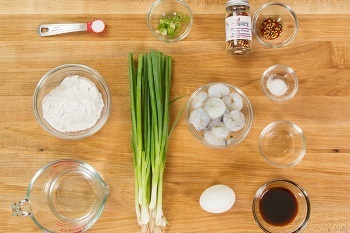
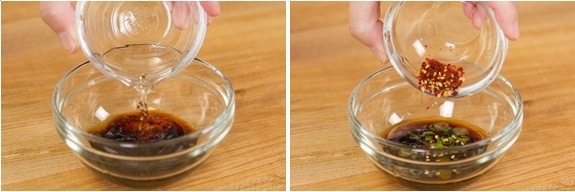

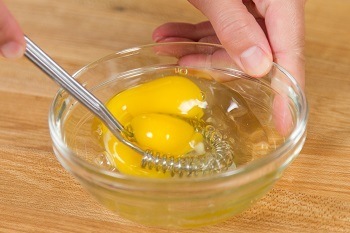




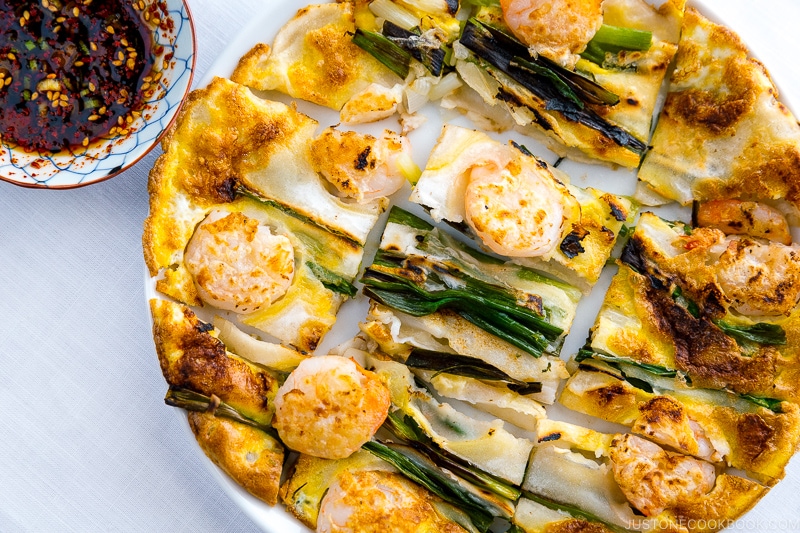











Finally, the recipe which is using basic ingredients and not products i.e. Korean pancake mix. Thank you for that.
Hi Jay! Hope you enjoy(ed) the recipe! 🙂
Thank you, we enjoyed. Unfortunately, I didn’t have green onion but used Vietnamese Chives instead, so it was not exact, but it was good and we will have it again sometimes. I will be checking your website for other recipes and try them out. Thank you.
Hi Jay! Thank you for your kind feedback. The chives sound great too! Hope you find some Japanese recipes that inspire you to cook at home! 🙂
Hi,Nami. I love korean pancake and always wanted to know how to make some. Thanks for this amazing recipe!
Hi Ashlynn! Hope you enjoy this recipe! 🙂
[…] Korean Pancake […]
Aloha Nami,
Again another awesome recipe! It was simple but “Oishiikatta, Massiseoda”. I’ve also added a little kimchi and imitation crabmeat. Arigato, Kahmsamnida! Keep the recipes coming!
Aloha Ethan! Glad to hear you enjoyed this recipe. Thank you for your kind feedback. 🙂
Hi Kat! Do you see egg is poured at step 8? You can completely omit egg at this step. Hope you enjoy!
“Then sift the mixture 2-3 times to evenly distribute the cornstarch.”
do you have a guide on how to sift flour?
Hi Alex! Oh! I have the video that I sifted both flour and corn starch.
Check out my video here: https://www.youtube.com/watch?v=V3VQMtLFpkU (Start at 1:22)
What do I use if I cant get Kosher Salt?
Hi Brian! I use kosher salt for cooking but you can use table salt. If so, please use half of the amount I specify in my recipe.
it show good Korean pancake….????????????????
Thank you Hannah! 🙂
I was looking for a recipe like the one my Korean friend makes, but she doesn’t read English so she can’t write down the ingredients. Her pancakes are leavened as are the pancakes I make, but without a leavening agent such as an egg or baking powder, won’t rise a bit, but will be more like a piece of flatbread. Did I miss something here? Adding the egg on top without it mixed in would not help.
I had these at a Korean restaurant the other day and there had to be a leavening agent in those.
Hi Marilyn!
I have Korean friends who use a leavening agent and who don’t.
I also quickly checked my Korean blogger friends’ recipes and also vary.
https://www.maangchi.com/recipe/pajeon
https://mykoreankitchen.com/korean-seafood-and-green-onion-pancakes-haemul-pajeon/
Some use pancake mix, tempura mix, etc too (which has baking powder in it).
The egg on top in this recipe is for the look/decoration only. 🙂
Dear Namiko – I don’t know if this recipe lost something in translation but I used 2 tbsp cornstarch and added it to the specified amount of regular flour and got something like cement. By the time I had thinned it out with water I still had far too much and the result had to be thrown in the trash. Something is wrong with your recipe!! Please advise if I have misunderstood. Regards Nicholas
Hi Nicholas! I think I know what went wrong. I think you added 2 Tbsp corn starch to 1/2 cup flour?
So the original recipe said “½ cup cake flour (add 2 Tbsp for every ½ cup) (½ cup + 2 Tbsp = 70 g) (See Notes)”. Basically what I meant is that you will need 1/2 cup + 2 Tbsp cake flour for this recipe and that’s 70 g of cake flour.
However, this recipe plugin (it’s a recipe writing tool) doesn’t allow me to add [1/2 cup + 2 Tbsp] in the amount area and only allows xx cup or xx gram.
So I wrote 1/2 cup in the amount box.
In reality, 1/2 cup cake flour is not enough and I have to add 2 Tbsp more. What I could do using this recipe plugin is that I add extra 2 Tbsp info in note section next to the ingredient entry. So I wrote “(add 2 Tbsp for every ½ cup)”.
However, the next problem for this recipe plugin is that ingredient amount changes based on serving size you decide. Bring the curser to the serving. You notice you can change from 1 to 2, etc.
If you decide to double the recipe, 1/2 cup becomes 1 cup. If you do that, you also need to add 4 Tbsp extra cake flour instead of 2 Tbsp. Therefore, I had to write “add 2 Tbsp for every 1/2 cup” in note.
I remember this recipe when I changed from old recipe plugin to this current recipe plugin. I could just write 1/2 cup cake flour. But I really added 2 Tbsp extra cake flour to get the right consistency, so I wanted to write and to write a precise recipe….
After your comment, I decided to write 70 g cake flour (70 g = 1/2 cup + 2 Tbsp). Hopefully people will understand you need 70 g (1/2 cup + 2 Tbsp) of cake flour.
I hope this makes sense? I truly apologize for the inconvenience.
Delicious!
Thank you Eva! 🙂
Hi I am trying to subscribe to your newsletter but it doesn’t like my email address. I have submitted 3 times without error but still cannot subscribe. Is it because I am in Australia.
Hi Jody! I added your email address manually but you have to confirm as I can’t confirm your subscription myself. 🙂
I’ll also delete your email address from your comment above for your privacy. 🙂
Wait,, what do you do with the half of the beaten egg? You don’t use it?
Hi Paula! If you are not making another pancake, you can save it for some other dishes or just pour all of it for the pancake. I like half of egg for my pancake this size. It’s up to you. 🙂
Can we use rice flour to make it?
Thank you Nami 🙂 It is so simple and still looks delicious! I will try it this weekend 🙂 <3
Hi Yvonne! Hope you enjoy this recipe this weekend! 🙂